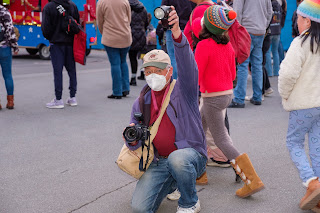As it turned out, the Redwood City Holiday Parade was scheduled for the same evening, so the assignment was a welcomed "twofer". The Parade started at 4:00 pm, well before the Train's 6:10 arrival, so I knew that I would have plenty of time to make the Money Shot. After some desperate minutes spent securing a parking space, I went to find the parade. Luckily for me, I spotted the staging area with dozens of marchers, so it was easy to find them after my car was secure. Since the Parade wasn't part of the assignment, I spent some time experimenting with my flash held off camera and triggered by a shoe-mounted radio controller. The Fuji TTL metering system has always been iffy at best, so I opted to determine the exposure manually.
This photo was sent to me by Jay Minares, a photographer who I know from the annual Bethlehem Christmas recreations in Redwood City. During the parade, I used this off-camera flash technique using a radio controller mounted on my Fuji X-T2. It was the technique used for the two parade photos, In the first example, the flash was properly directed towards the subjects, giving me even illumination right down to the marcher's shoes. The second shot shows the flash pointed slightly upward, a happy accident that emphasized the closer marcher without overexposing her legs. It can be difficult aiming both the camera and the flash at the exact same spot, and near-misses are common.
 |
| 1/30, F 6.4, ISO 6400 |
I am pleased with these two marching shots. You can see from the exposure that I was stretching the capability of the camera, as the ISO setting was the highest value available to me. 1/30 of a second was obviously not enough to prevent the motion blur of one marcher's waving hand.
 |
| 1/60, F 8.0, ISO 6400 |
When this second group of marchers appeared, I knew that I would have to cut back on the flash output. If memory serves, I was running at 1/128 power, so I opted to stop down one stop. Coincidentally, I decreased the exposure time by a full stop in an attempt to recover the lettering on the theater marque in the background. This might have been an interesting photo to submit, although it was heavy on context and light on content.
Exposure Considerations: As ordinary as these two photos appear, there was a lot of exposure juggling behind them. First, there is the foreground, whose exposure is determined by the flash output and the aperture. The second and third exposure settings are the Fox marque and the sky, which are controlled by the exposure time. Underexposure can correct the overexposure of the marque, but will consequently darken the sky. In the second shot, the sky/marque exposure were reduced by 1 2/3 stops, a combination of a reduced aperture size to compensate for the decreased subject/flash distance, and the decrease in exposure time. The balancing act was made more arduous by the difficulty in adjusting the flash output using the on-camera flash commander. More on that in a later post.
Parade Chasing: Parades are moving targets, and the photographer is confronted with a choice. One can stay in one spot and wait for the perfect image to appear, or one can find a suitable subject and move along with it, photographing it whenever an opportunity presents itself. I chose the former approach when I found that the Fox Theater made a great backdrop, and the my wide angle lens could accommodate the evening sky, and my subjects in the foreground.
The Train Station was a short walk away from the parade route. I arrived with plenty of time to prepare for the train's arrival.

The decorated Holiday Train arrived right on time. Barricades were arranged on the boarding platform to provide an unobstructed path for Mr. and Mrs. Claus, Rodolph, Frosty, and Victorian Era Carolers to parade before the audience, This was my first Holiday Train photo assignment, and I was surprised to see how popular the event was. Nearly all of the photos were made from the "Hail Mary" technique, the one where the camera is held high overhead.
Children of all ages stood behind the barricade. Wherever I went I was in danger of accidentally stepping on some small munchkin, so I did my best to keep a safe distance and go for the high-overhead shot. The flash technique was changed from my earlier off-camera technique to simply mounting the flash on the camera, adding a diffusion dome and adjusting the flash head to about 45 degrees to maximize the flash coverage and raise the flash's height just a smidge.
Rat-Tat-Tat: Because the flash output was so low, I was able to set the camera to the Continues Low Speed Burst mode. This allowed me to fire bursts of three to five shots before the flash was exhausted. This is a manual-exposure-only technique that can help capture those fleeting moments as the entertainers walked back and forth only the barricade in an effort to give a smile to every spectator.
When photographing at relatively short distances (I was using a 10-24 F 4.0 zoom lens) the relatively modest elevation of the shoe-mounted flash can provide just enough height to provide some modeling on my subject's face. But when working in such cramped quarters as I did this evening, a shoe-mounted flash with an angled diffuser dome is the best you can do. I did have a Gary Fong Light Sphere in my bag, but was afraid that it would be easily knocked off of the flash head and lend where it couldn't be retrieved. However, the burst-firing of my camera coupled with the high ISO setting and minimal output of the flash worked out well on this assignment. Not particularly creative, but it gets the job done.





No comments:
Post a Comment